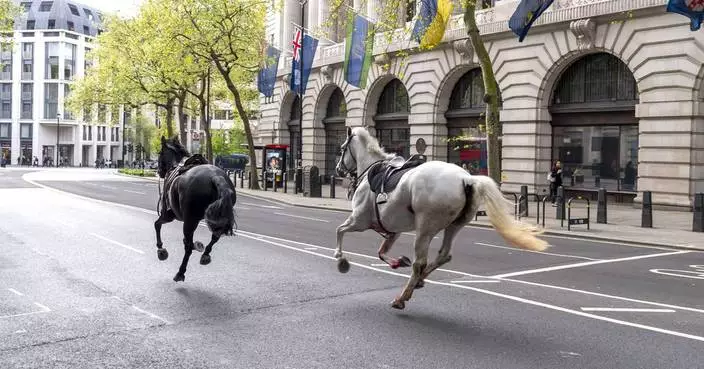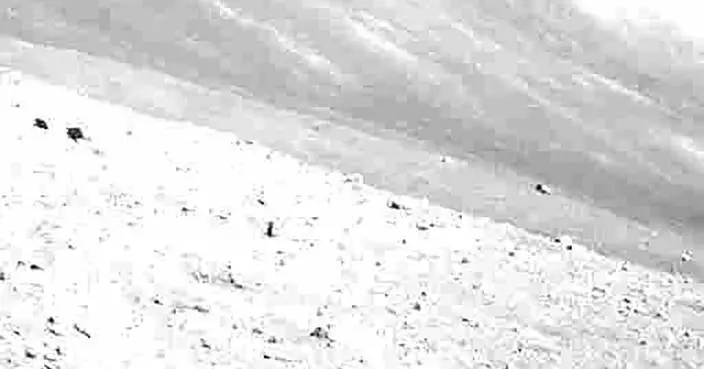Feature · News

Brazilian vice president upbeat about China-Brazil cooperation

62 dead in shipwreck, CAR President declares 3 days of mourning

Military officials call for enhanced dialogue, communication at naval symposium

US fiscal deficit poses complex economic challenges for globe: expert

China's education reform plan implenmented on nine basic disciplines

Liaoning strives to achieve comprehensive revitalization: governor

Criticism grows as Japan starts 5th ocean discharge of Fukushima nuclear-tainted wastewater

China to work with PNG to strengthen comprehensive strategic partnership: foreign minister

Chinese economy achieves good start in Q1: official

Chinese mainland, HK agree to broaden eligible stock ETFs under Stock Connect program

Tongwei Solar: from fish farming operator to leading global solar panel manfacturer

More batches of Chinese humanitarian aid supplies to Gaza arrive in Egypt

Public interacts with navymen at Open Day event in Liaoning

Hannover Messe highlights importance of Germany-China cooperation in Sustainable Industry

Senior volunteers deliver meals, extends warmth to vulnerable elderly

US veto against Palestinian request proves it as peace spoiler, war peddler: commentary
Criticism grows as Japan starts 5th ocean discharge of Fukushima nuclear-tainted wastewater

China to work with PNG to strengthen comprehensive strategic partnership: foreign minister
Chinese economy achieves good start in Q1: official

Chinese mainland, HK agree to broaden eligible stock ETFs under Stock Connect program

Brazilian vice president upbeat about China-Brazil cooperation
62 dead in shipwreck, CAR President declares 3 days of mourning
Military officials call for enhanced dialogue, communication at naval symposium
US fiscal deficit poses complex economic challenges for globe: expert

China's education reform plan implenmented on nine basic disciplines
Liaoning strives to achieve comprehensive revitalization: governor

Tongwei Solar: from fish farming operator to leading global solar panel manfacturer

More batches of Chinese humanitarian aid supplies to Gaza arrive in Egypt
Public interacts with navymen at Open Day event in Liaoning
Hannover Messe highlights importance of Germany-China cooperation in Sustainable Industry

Senior volunteers deliver meals, extends warmth to vulnerable elderly

US veto against Palestinian request proves it as peace spoiler, war peddler: commentary

Biden signs a $95 billion war aid measure with assistance for Ukraine, Israel and Taiwan
- New Jersey is motivating telecommuters to appeal their New York tax bills. Connecticut may be next
- Judge to probe corruption accusation against wife of Spain's leader filed by right-wing group
- Paris will become a no-fly zone to safeguard its wildly ambitious Olympic opening ceremony
- Accessia Health Appoints Tiara Green to President
- What a TikTok ban in the US could mean for you
- Supreme Court weighs whether states can ban abortion, even during some medical emergencies
- IAEA team inspects treated radioactive water release from Japan's Fukushima nuclear plant
- Indonesia declares Prabowo Subianto president-elect after court rejects rivals' appeal
- Doctors combine a pig kidney transplant and a heart device in a bid to extend woman's life

Female cinematographer aims to inspire more women to pursue dreams
- Immigrants needed to boost U.S. economy: immigration activist
- Int’l community already sees through US hegemony in guise of human rights
- Forum Macao guests highlight opportunities, win-win cooperation
- Visa free policy ignites enthusiasm among Thais to travel to China
- China ready to bring more opportunities to Asia-Pacific region: spokesman
- China sees cross-border tourism boom in Q1
- PLA Navy celebrates 75th founding anniversary with open day events
- China urges US to remove all additional tariffs: spokesman
- Shenzhou-18 crewed spaceship ready for launch

What to listen for during Supreme Court arguments on Donald Trump and presidential immunity
- Iran's Raisi inaugurates project in Sri Lanka, says West doesn't monopolize knowledge, technology
- Norfolk Southern's earnings offer railroad chance to defend its strategy ahead of board vote
- TikTok may be banned in the US. Here's what happened when India did it
- Stock market today: Wall Street edges higher as more earnings come in ahead of inflation data
- Biden tries to navigate the Israel-Hamas war protests roiling college campuses
- Surging auto insurance rates squeeze drivers, fuel inflation
- Cisco Systems joins Microsoft, IBM in Vatican pledge to ensure ethical use and development of AI
- Zilch Selects Amazon Web Services to Accelerate AI Innovation
- German retirees will get an inflation-busting pension increase this year

Ouro and Real Madrid Partner to Deliver Innovative Financial Products to Football Fans Around the Globe
- Angry farmers in a once-lush Mexican state target avocado orchards that suck up too much water
- Japan's moon lander wasn't built to survive a weekslong lunar night. It's still going after 3
- Forsberg and Beauvillier each get a goal and an assist and Predators knock off Canucks 4-1
- FPT Cooperates with USAID to Promote Clean Energy Deployment, Reduce Greenhouse Gas Emissions, and Accelerate Net Zero Transition
- With public universities under threat, massive protests against austerity shake Argentina
- Bobrovsky makes incredible save during Panthers-Lightning playoff game
- Senate passes bill forcing TikTok's parent company to sell or face ban, sends to Biden for signature
- Tabloid publisher says he pledged to be Trump campaign's 'eyes and ears' during 2016 race
- Tesla 1Q profit falls 55%, but stock jumps as company moves to speed production of cheaper vehicles

Josef Newgarden’s win in IndyCar’s season-opening race has been disqualified. O'Ward named winner
- Publishing spinoff of 'Wednesday' has everything from tarot cards to 'Woeful Waffles'
- The Latest | Germany will resume working with UN relief agency for Palestinians after a review
- Complex stories of migration are among the finalists for the Women's Prize for Fiction
- Pro-Palestinian student protests target colleges' financial ties with Israel
- Olympian Kristi Yamaguchi is 'tickled pink' to inspire a Barbie doll
- Philadelphia's Tyrese Maxey edges Chicago's Coby White, wins NBA's Most Improved Player award
- Photographer alleges he was forced to watch Megan Thee Stallion have sex and was unfairly fired
- Phish fans are famously dedicated. What happens when they enter the Sphere?
- Ashley Judd and Aloe Blacc help the White House unveil its national suicide prevention strategy

Reggie Bush is reinstated as 2005 Heisman Trophy winner, with organizers citing NIL rule changes
- Carli Lloyd turns diplomat and takes a US message to kids in Greece
- First-round picks could be on the trading block on Day 1 of the NFL draft
- Austria coach Ralf Rangnick confirms Bayern Munich contact
- Marcel Hirscher is coming out of retirement. He plans to ski for the Netherlands, his mom's nation
- Columbia University cites progress with Gaza war protesters after encampment arrests
- Nadal says he is not 100% fit ahead of Madrid debut. Spaniard still unsure about playing French Open
- Australian police arrest 7 alleged teen extremists linked to stabbing of a bishop in a Sydney church
- Biden administration finalizes rule to grant overtime for millions more salaried workers
- Avalanche score 4 in 2nd period, beat Jets 5-2 and even first-round playoff series at 1-1

International Conference on Building Data Acquisition, Ontology and Modeling concludes
- HKMA issues alert regarding specific website
- CE meets Secretary of CPC Shenzhen Municipal Committee
- Civil Service College holds seminar on "Global Economic Change and National Security"
- LCQ3: Non-locally trained doctors and medical graduates
- LCQ5: Training foreign-related legal talents
- SCST meets with Chairman of CPPCC Qingdao Municipal Committee
- Suspected red tide sighted at Deep Water Bay Beach, Repulse Bay Beach, South Bay Beach and Shek O Beach
- LCQ6: Sai Yee Street/Flower Market Road Development Scheme
- LegCo Panel on Transport visits "Station Rail Voyage" Exhibition at Hung Hom Station

US uses overcapacity as excuse to impose trade protectionism: former Italian official
- Flood-hit Guangdong town secures supplies for evacuated residents at relocation sites
- AI heralds new wave of industrial revolution at Hannover Messe 2024
- Switzerland remains safe despite passionate gun culture
- Regional free trade agreement brings newcomers to Canton Fair
- Chinese envoy calls for concerted efforts to crack down gang violence in Haiti
- China's Q1 employment stability and social security fund growth underscore economic resilience
- China opposes US groundless accusations against normal China-Russia trade
- Versatile naval capabilities of Chinese missile destroyer Guiyang on display to public
- Flight tickets in high demand for China's upcoming May Day holiday
Category · News

Biden signs a $95 billion war aid measure with assistance for Ukraine, Israel and Taiwan

Reggie Bush is reinstated as 2005 Heisman Trophy winner, with organizers citing NIL rule changes

New Jersey is motivating telecommuters to appeal their New York tax bills. Connecticut may be next

Carli Lloyd turns diplomat and takes a US message to kids in Greece

Judge to probe corruption accusation against wife of Spain's leader filed by right-wing group

Paris will become a no-fly zone to safeguard its wildly ambitious Olympic opening ceremony

First-round picks could be on the trading block on Day 1 of the NFL draft

Accessia Health Appoints Tiara Green to President

Austria coach Ralf Rangnick confirms Bayern Munich contact

Josef Newgarden’s win in IndyCar’s season-opening race has been disqualified. O'Ward named winner

What a TikTok ban in the US could mean for you

Marcel Hirscher is coming out of retirement. He plans to ski for the Netherlands, his mom's nation

Supreme Court weighs whether states can ban abortion, even during some medical emergencies

IAEA team inspects treated radioactive water release from Japan's Fukushima nuclear plant

Indonesia declares Prabowo Subianto president-elect after court rejects rivals' appeal

Publishing spinoff of 'Wednesday' has everything from tarot cards to 'Woeful Waffles'

Doctors combine a pig kidney transplant and a heart device in a bid to extend woman's life

Ouro and Real Madrid Partner to Deliver Innovative Financial Products to Football Fans Around the Globe

Rush hour chaos in London as 5 military horses run amok after getting spooked during exercise

What to listen for during Supreme Court arguments on Donald Trump and presidential immunity

Columbia University cites progress with Gaza war protesters after encampment arrests

The Latest | Germany will resume working with UN relief agency for Palestinians after a review

Longtime EU hopeful North Macedonia holds presidential polls centered on bloc accession, rule of law

Nadal says he is not 100% fit ahead of Madrid debut. Spaniard still unsure about playing French Open

Iran's Raisi inaugurates project in Sri Lanka, says West doesn't monopolize knowledge, technology

German leader says Europe must keep increasing aid to Ukraine after US approves new military help

‘World of Coffee & World Barista Championship Busan 2024’ to Launch on May 1st

Norfolk Southern's earnings offer railroad chance to defend its strategy ahead of board vote

TikTok may be banned in the US. Here's what happened when India did it

Stock market today: Wall Street edges higher as more earnings come in ahead of inflation data

Cantaloupe, Inc.’s 2024 Micropayment Trends Report Reveals Surge in Cashless and Touchless Payments, and Micro Market Growth

The Antera Brand Back at the Summit of Light Alloy-wheel Producers

Biden tries to navigate the Israel-Hamas war protests roiling college campuses

Tufts Medicine, Navvis Partner to Accelerate Value-Based Care, Driving Healthcare Transformation in Massachusetts

More US aid will help Ukraine avoid defeat in its war with Russia. Winning is another matter

Ex-leader of Northern Ireland's biggest unionist party faces sex offense charges dating to 1985

International Conference on Building Data Acquisition, Ontology and Modeling concludes

Surging auto insurance rates squeeze drivers, fuel inflation

HKMA issues alert regarding specific website

Cross Country EVP, Chief Administrative Officer and General Counsel Named to Global Top 50 Corporate Counsel List

Dell’Oro Group Names Vecima Global Market Share Leader in Fiber Remote OLTs and DAA Remote MACPHY for Third Consecutive Year

Cisco Systems joins Microsoft, IBM in Vatican pledge to ensure ethical use and development of AI

Zilch Selects Amazon Web Services to Accelerate AI Innovation

German retirees will get an inflation-busting pension increase this year

CE meets Secretary of CPC Shenzhen Municipal Committee

Top Russian military official appears in court on bribery charges

Horizon FCB Dubai Charts the Future of Advertising in Logistics with DHL’s “Delivered Yesterday” Campaign

Australian police arrest 7 alleged teen extremists linked to stabbing of a bishop in a Sydney church

2024 Talent Experience Award Winners Celebrated at IAMPHENOM

Avēsis and Harmony Health Launch Pioneering Salivary Testing Pilot for Patients with Special Healthcare Needs

Biden administration finalizes rule to grant overtime for millions more salaried workers

Civil Service College holds seminar on "Global Economic Change and National Security"

LCQ3: Non-locally trained doctors and medical graduates

Moscow court rejects Evan Gershkovich's appeal, keeping him in jail until at least June 30

Biden administration is announcing plans for up to 12 lease sales for offshore wind energy

Vantage Data Centers Expands EMEA Portfolio with First Dublin Campus Featuring Next-Generation Energy Solution

LCQ5: Training foreign-related legal talents

SCST meets with Chairman of CPPCC Qingdao Municipal Committee

Suspected red tide sighted at Deep Water Bay Beach, Repulse Bay Beach, South Bay Beach and Shek O Beach

Angry farmers in a once-lush Mexican state target avocado orchards that suck up too much water

LCQ6: Sai Yee Street/Flower Market Road Development Scheme

LegCo Panel on Transport visits "Station Rail Voyage" Exhibition at Hung Hom Station

Ukrainian officials thank the US for its latest military aid to help stop Russia's onslaught

Appeal for information on missing man in Western District

Government announces ceiling price adjustment mechanism for charging electric taxis and electric public light buses at designated charging stations and extension of tender invitation periods for sales of two lots for converting into quick charging stations for electric vehicles

Japan's moon lander wasn't built to survive a weekslong lunar night. It's still going after 3

Danfoss Selects RISE with SAP and HPE GreenLake to Accelerate Sustainable Cloud Journey

LCQ18: Preparatory work for coping with inclement weather

Enhanced security measures at High Court Building

Exclusive Selections to Prepare for Summer: April Offers of Tineco

Bringing Freshness into your Cleaning: April Deals from Tineco

LCQ11: Fire safety of old buildings

The Missing Piece - TUC s.r.l presents TUC.tiny: the key to access New Mobility

LCQ12: Regulation of health food products

LCQ4: Manpower of dentists

Inspection of aquatic products imported from Japan

Complex stories of migration are among the finalists for the Women's Prize for Fiction

AP News Digest 3 a.m.

Auction of traditional vehicle registration marks to be held on May 12

LCQ13: Handling of cases of illegal conversions and unauthorised building works

LCQ8: Mental Health Support Hotline

Forsberg and Beauvillier each get a goal and an assist and Predators knock off Canucks 4-1

LCQ2: Promoting professional development of manipulative therapy industry

Avalanche score 4 in 2nd period, beat Jets 5-2 and even first-round playoff series at 1-1








































